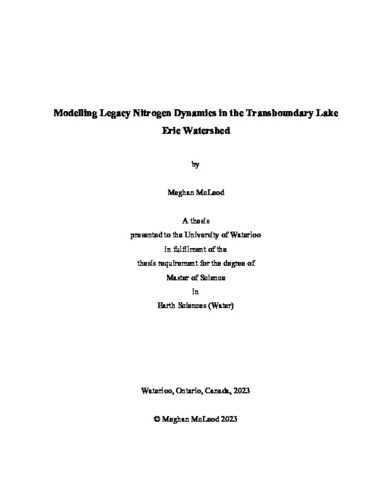| dc.description.abstract | Lake Erie is a source of drinking water, recreation, and commercial opportunity for both the United
States and Canada, making the protection of its water quality essential. In the past decades, Lake
Erie's ecosystems have been adversely affected by recurring toxic algal blooms. These algal blooms
are attributed to nitrogen (N) and phosphorus pollution from agricultural runoff. Despite recent
efforts to reduce N application in the Lake Erie basin, high levels of N concentration persist in
surface and groundwater systems. One of the reasons for this apparent stasis in N concentrations is
legacy stores of N in landscapes that contribute to lag times in water quality response, even after
inputs have ceased. Legacy N is stored in the soil and slow-moving groundwater and makes up a
large portion of current N contamination. Quantifying these available legacy N stores is essential for
creating nutrient reduction targets.
In this thesis, the variance of N inputs and legacy N across different sub-watersheds in the
transboundary Lake Erie basin (LEB) are explored. First, I synthesised 2-century-long (1800-2016) N
input and output datasets for 45 sub-watersheds across the basin. Specifically, I accounted for manure
application, fertilizer, biological N fixation, domestic wastewater N, atmospheric N deposition, and
agricultural N uptake. I then used the ELEMeNT modelling framework with these inputs to simulate
N loading at the outlet for all 45 sub-watersheds and quantified N retention across the watershed over
time. The models performed well overall with a median PBIAS of 1.9% (IQR: 0.7% -3.1%) and a
median KGE (Kling Gupta Efficiency) of 0.75 (IQR: 0.66 to 0.88) between modelled and measured
N loading across the sub-watersheds. Additionally, the models were able to simulate accumulated soil
organic nitrogen (SON) values quite well, with a median PBIAS of 12.6% between modelled and
measured SON.
The results show that N surplus (the difference between N inputs and non-hydrological N outputs)
has been rising across most Lake Erie sub-watersheds since 1950 and has only started to plateau or
decrease around 2000. Agricultural inputs from manure, fertilizer, and biological fixation were the
lead contributors to N surplus in agricultural watersheds, and domestic N was the lead N contributor
in urban sub-watersheds. Since 1950, between 4% and 44% of N has been stored as legacy N (23%
median). On average 92% of this N legacy is retained in the soil and 8% is in the groundwater.
Through correlation analysis I have found that higher fractions of groundwater N and SON legacy
accumulation are correlated with slower travel times and lower tile drainage, while wastewater
denitrification emerged as the dominant component in urban sub-watersheds. These results provide
insight about drivers of legacy N and N release in sub-watersheds, which could aid in targeted
nutrient management across the watershed | en |

